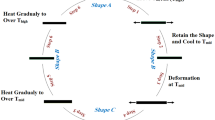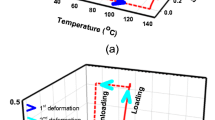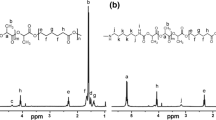Abstract
In this work, a biodegradable polycaprolactone (PCL)/poly (butyleneadipate-co-terephthalate) (PBAT) shape memory blend was prepared by melt blending. The influence of PBAT on the thermal properties of PCL was investigated by thermogravimetric (TG) measurement, differential scanning calorimetry (DSC), polarized optical microscopy (POM), and X-ray diffraction (XRD) methods. The results of TGA and DSC showed that with the increase of PBAT, thermal properties of the blends were improved. The crystallization test revealed that as the mass fraction of PBAT increased, crystallinity of PCL gradually decreased and its crystal size decreased. The thermal and shear stability of the PCL/PBAT shape memory blend were analyzed. With the increase of PBAT mass fraction, the equilibrium torque of PCL/PBAT shape memory blend increased gradually, from 1.5 to 2.5 Nm, but compared with the balancing torque of pure PCL of 4.56 Nm, both were smaller than it. Finally, taking the melting point as the switch temperature (Ts) of the blend, the bending test showed that the shape memory fixation rate and recovery rate were 96% and over 80%, respectively. Because of its biodegradability, good thermomechanical properties, low cost, and other advantages, the PCL/PBAT shape memory blend showed a high application issues.
Graphical abstract










Similar content being viewed by others
Data availability
Data will be made available on request.
References
Sarvari R, Keyhanvar P, Agbolaghi S, Gholami Farashah MS, Sadrhaghighi A, Nouri M, Roshangar L (2022) Shape-memory materials and their clinical applications. Int J Polym Mater Polym Bio 71:315–335
Pekdemir ME, Öner E, Kök M, Qader IN (2021) Thermal behavior and shape memory properties of PCL blends film with PVC and PMMA polymers. Iran Polym J 30:633–641
Liu Q, Jiang L, Zhao Y, Wang Y, Lei J (2019) Reprocessable and shape memory thermosetting epoxy resins based on silyl ether equilibration. Macromol Chem Phys 220:1900149
Czifrak K, Lakatos C, Arpad Kordovan M, Nagy L, Daroczi L, Zsuga M, Keki S (2020) Block copolymers of poly(omega-pentadecalactone) in segmented polyurethanes: novel biodegradable shape memory polyurethanes. Polymers (Basel) 12:1928
Jiang Z, Wang Y, Huang Z, Ma W, Gao S, Dong W, Xu M (2022) Green and sustainable cellulose-based shape memory composites with excellent conductivity for temperature warning. Carbohydr Polym 276:118767
Zhang L, Lin Z, Zhou Q, Ma S, Liang Y, Zhang Z (2020) PEEK modified PLA shape memory blends: towards enhanced mechanical and deformation properties. Front Mater Sci 14:177–187
Jing X, Mi H-Y, Peng X-F, Turng L-S (2015) The morphology, properties, and shape memory behavior of polylactic acid/thermoplastic polyurethane blends. Polym Eng Sci 55:70–80
Shuai L, Jun Z, Jianjun C, Ming Y, Xuepeng L, Zhiguo J (2019) Biodegradable body temperature-responsive shape memory polyurethanes with self-healing behavior. Polym Eng Sci 59:E310–E316
Yeo JCC, Ong XY, Koh JJ, Kong J, Zhang X, Thitsartarn W, Li Z, He C (2021) Dual-phase poly(lactic acid)/poly(hydroxybutyrate)-rubber copolymer as high-performance shape memory materials. ACS Appl Polym Mater 3:389–399
Mishra B, Sharma S (2021) Shape memory materials with reversible shape change and self-healing abilities: a review. Mater Today Proc 44:4563–4568
Qiu Y, Xi J, Wanyan Q, Wu D (2020) Selectively Sensing capacities of biocompatible shape memory materials based on cross-linked poly (l-malic acid): visual discrimination of the solvents with similar structures. ACS Appl Polym Mater 2:1672–1681
Sousa FM, Cavalcanti FB, Marinho VAD, Morais DDS, Almeida TG, Carvalho LH (2022) Effect of composition on permeability, mechanical properties and biodegradation of PBAT/PCL blends films. Polym Bull 79:5327–5338
Moustafa H, Galliard H, Vidal L, Dufresne A (2017) Facile modification of organoclay and its effect on the compatibility and properties of novel biodegradable PBE/PBAT nanocomposites. Eur Polym J 87:188–199
He H, Liu B, Xue B, Zhang H (2022) Study on structure and properties of biodegradable PLA/PBAT/organic-modified MMT nanocomposites. J Thermoplast Compos Mater 35:503–520
Li K, Song J, Xu M, Kuga S, Zhang L, Cai J (2014) Extraordinary reinforcement effect of three-dimensionally nanoporous cellulose gels in poly(epsilon-caprolactone) bionanocomposites. ACS Appl Mater Interf 6:7204–7213
Huang M, Zhou C, Ling Y, Zhao G, Dong L, Shi J, Chen J (2022) Preparation and characterisation of PCL shape-memory films via photo-crosslinking. Plast Rubber Compos 51:47–54
Woodruff MA, Hutmacher DW (2010) The return of a forgotten polymer—Polycaprolactone in the 21st century. Prog Polym Sci 35:1217–1256
Branciforti MC, Bellani CF, Lipparelli Morelli C, Ferr A, Benkirane-Jessel N, Suman Bretas RE (2019) Poly(butylene adipate-co-terephthalate and poly(ɛ-caprolactone and their bionanocomposites with cellulose nanocrystals: thermo-mechanical properties and cell viability study. J Renew Mater 7:269–277
Zhang S, He Y, Lin Z, Li J, Jiang G (2019) Effects of tartaric acid contents on phase homogeneity, morphology and properties of poly (butyleneadipate-co-terephthalate)/thermoplastic starch bio-composities. Polym Test 76:385–395
Zhou J, Zheng Y, Shan G, Bao Y, Wang W-J, Pan P (2020) Stretch-induced crystalline structural evolution and cavitation of poly(butylene adipate-ran-butylene terephthalate)/poly(lactic acid) immiscible blends. Polymer 188:122121
Li X, Tan D, Xie L, Sun H, Sun S, Zhong G, Ren P (2018) Effect of surface property of halloysite on the crystallization behavior of PBAT. Appl Clay Sci 157:218–226
Bai J, Pei H, Zhou X, Xie X (2021) Reactive compatibilization and properties of low-cost and high-performance PBAT/thermoplastic starch blends. Eur Polym J 143:110198
Sousa FM, Costa ARM, Reul LTA, Cavalcanti FB, Carvalho LH, Almeida TG, Canedo EL (2019) Rheological and thermal characterization of PCL/PBAT blends. Polym Bull 76:1573–1593
Lai S-M, You P-Y, Chiu YT, Kuo CW (2017) Triple-shape memory properties of thermoplastic polyurethane/olefin block copolymer/polycaprolactone blends. J Polym Res 24:161
Acknowledgements
Financial support was kindly supplied by Class A project of Liaoning Education Department (LJKZ0513). Support was provided by the Liao Ning Revitalization Talents Program (XLYC1906017). Support was also provided by Youth Science and Technology Talent Project from Liaoning Provincial Education Department(J2019046).
Author information
Authors and Affiliations
Corresponding author
Ethics declarations
Conflict of interest
All authors declare that no conflict of interest exists.
Rights and permissions
Springer Nature or its licensor (e.g. a society or other partner) holds exclusive rights to this article under a publishing agreement with the author(s) or other rightsholder(s); author self-archiving of the accepted manuscript version of this article is solely governed by the terms of such publishing agreement and applicable law.
About this article
Cite this article
Yang, B., Xia, Y., Zhou, H. et al. Thermal and crystalline properties of biodegradable PCL/PBAT shape memory blends. Iran Polym J 32, 791–800 (2023). https://doi.org/10.1007/s13726-023-01157-w
Received:
Accepted:
Published:
Issue Date:
DOI: https://doi.org/10.1007/s13726-023-01157-w




